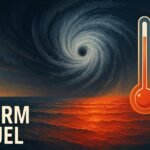Ever wondered why we name storms—and why these powerful forces of nature get male and female names? It’s not just a quirky tradition; there’s a practical, historical, and fascinating reason behind the practice of naming storms.
A Quick History of Naming Storms
Long before official lists existed, storms were tagged with saints’ days or simply named after geographic areas they devastated. Back in the late 1800s, Australian meteorologist Clement Wragge even began giving storms politicians’ names he disliked—talk about making a point!
But it wasn’t until 1953 that the U.S. started officially naming hurricanes using only female names. This made storms easier to communicate, especially in radio broadcasts, but eventually drew criticism. By the late 1970s, it was clear a change was needed.
Introducing Male Names: A Step Towards Equality
1979 marked a major turning point. The first officially male-named Atlantic hurricane, “Bob,” appeared, thanks to advocacy for gender equality and fairness. This introduced the alternating system we’re familiar with today: Ana, Bill, Claudette—switching between female and male names to maintain balance.
How Does Naming Storms Work Today?
Storm names aren’t random. The World Meteorological Organization (WMO) oversees the lists, carefully curating names that reflect regional cultures, are easy to pronounce, and distinct enough to prevent confusion.
These names rotate every six years, but here’s an interesting twist—when a storm becomes notoriously destructive, its name gets retired. That’s why you’ll never see another Katrina or Sandy, ensuring sensitivity to communities impacted.
Why Do We Even Need to Name Storms?
Naming storms isn’t just about convenience—it’s essential for safety. Studies show people remember named storms more easily, respond quicker to warnings, and engage better with emergency instructions than they do with numbered advisories.
Think about it: would you remember “Storm 2025-07” or “Hurricane Emma“? Exactly.
Naming Storms and Public Perception
Interestingly, some studies suggest the gender of storm names might influence public response. A controversial study in 2014 argued female-named storms were underestimated, resulting in higher casualties. While disputed, it highlights the psychological power names might have on preparedness and response.
Regional Differences and Cultural Influences
Each cyclone-prone region has its unique flavor when naming storms. For instance, Australia’s cyclone names often feature Indigenous words, like Cyclone Yasi, making these storms distinctly recognizable and culturally resonant. Meanwhile, in the UK, storms are crowdsourced—citizens actively vote to name their storms, fostering community involvement and awareness.
Naming Storms Matters
Next time you hear a storm’s name announced, remember the thoughtful history and purposeful strategy behind it. Naming storms isn’t merely tradition; it’s an essential part of disaster communication, designed to save lives, boost awareness, and enhance public safety.
After all, when nature shows its fierce side, clarity matters—and a memorable name can make all the difference.


